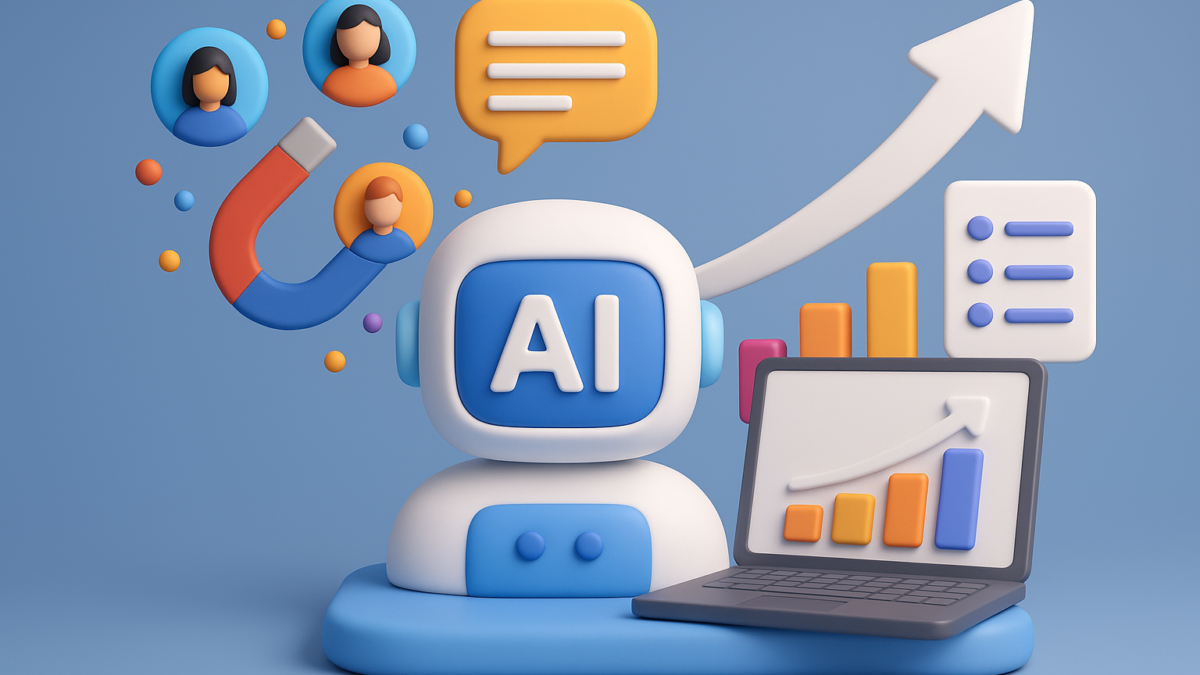Lead generation has always been at the heart of every successful B2B marketing strategy. But as buyer behaviors evolve and competition intensifies, traditional methods like manual outreach and broad email campaigns are no longer enough.
Enter Artificial Intelligence (AI) a technology that is redefining how businesses identify, nurture, and convert leads. From predictive analytics to automated personalization, AI is reshaping the way companies attract high-quality prospects and accelerate sales.
1. What is AI-Powered Lead Generation?
AI in lead generation uses data-driven algorithms, automation, and machine learning models to find, score, and engage potential customers more efficiently. Instead of relying on guesswork, marketers can now use intelligent systems to predict who is most likely to convert — and when.
Key Components of AI Lead Generation:
- Predictive Analytics: Forecasts which leads are most valuable.
- Natural Language Processing (NLP): Helps chatbots and assistants communicate naturally with prospects.
- Machine Learning Models: Continuously improve targeting and personalization.
- Data Enrichment: Cleans and enhances customer databases with real-time insights.
2. How AI Improves the Lead Generation Process
AI enhances every stage of the lead generation funnel — from awareness to conversion:
a. Smarter Audience Targeting
AI tools analyze thousands of data points — demographics, behavior, intent signals, and engagement — to identify ideal customer profiles (ICPs).
This ensures your campaigns reach decision-makers most likely to engage with your solution.
b. Automated Lead Scoring
Instead of manually ranking leads, AI assigns a predictive score based on their likelihood to convert.
For example, a lead who visits your pricing page multiple times or engages with your webinars will automatically move to the top of your priority list.
c. Conversational AI & Chatbots
AI chatbots engage with visitors in real-time, qualify leads, and even schedule sales calls — all without human intervention.
They can understand user intent using NLP and provide relevant information instantly, enhancing the customer experience.
d. Hyper-Personalized Campaigns
AI analyzes user behavior to create personalized content and email recommendations for each lead.
For instance, if a prospect downloads a whitepaper on “Marketing Automation,” the system can automatically follow up with a tailored case study or demo invite.
3. Predictive Analytics: The Game-Changer
Predictive analytics uses historical data and machine learning to forecast which leads are most likely to convert.
How It Works:
- Collects behavioral and demographic data.
- Analyzes previous conversion patterns.
- Scores leads based on intent and engagement levels.
Example:
A B2B SaaS company might discover through AI analytics that leads coming from LinkedIn with “Marketing Manager” titles have a 40% higher conversion rate — allowing them to focus more budget on that channel.
4. AI-Powered Tools Transforming Lead Generation
Here are some popular AI tools reshaping B2B lead generation in 2025:
- HubSpot AI: For lead scoring, smart content, and automated workflows.
- ZoomInfo Intent AI: Tracks buying intent signals from across the web.
- Drift: AI chatbots for conversational marketing and instant lead qualification.
- Leadfeeder: Identifies anonymous website visitors and company-level insights.
- 6sense: Predictive analytics for identifying in-market accounts.
These tools not only automate lead generation but also improve accuracy, personalization, and sales efficiency.
5. The Role of Generative AI in Content Creation
In 2025, Generative AI is revolutionizing how content fuels lead generation.
From personalized email campaigns to AI-generated landing page copy, businesses are leveraging tools like ChatGPT to create high-performing content at scale.
Applications:
- AI-written blogs and whitepapers optimized for SEO.
- Personalized ad copy based on audience segments.
- Dynamic landing pages that adapt to visitor behavior.
Result: Better engagement, improved lead quality, and reduced content production time.
6. AI + Human Collaboration: The Perfect Balance
While AI automates the technical aspects of lead generation, human expertise remains critical for strategy, creativity, and relationship-building.
AI Handles:
- Data processing
- Predictive analytics
- Real-time personalization
Humans Handle:
- Storytelling
- Brand positioning
- Strategic decision-making
Together, they create a system that is both intelligent and emotionally resonant.
7. Real-World Impact of AI in Lead Generation
Businesses adopting AI in lead generation are already seeing measurable results:
- 35% increase in conversion rates through predictive scoring.
- 50% reduction in manual prospecting time.
- 3x ROI improvement through hyper-targeted campaigns.
For instance, a B2B SaaS provider using AI-driven content syndication can automatically distribute whitepapers to decision-makers in relevant industries — generating qualified leads at scale without wasting marketing budget.
8. Future of AI in Lead Generation
As AI evolves, lead generation will become more autonomous, predictive, and personalized.
Upcoming innovations include:
- Voice-based AI assistants for sales teams.
- Real-time intent prediction based on micro-interactions.
- Autonomous campaign optimization that adjusts strategies on the fly.
In essence, AI will enable marketers to move from “reactive” to proactive lead generation — reaching prospects even before they start searching.
Conclusion
AI is no longer a futuristic concept it’s the present and future of B2B lead generation. With smarter targeting, predictive analytics, and automated engagement, AI empowers businesses to focus on what truly matters: building relationships and driving conversions.
Call-to-Action (CTA)
Supercharge your B2B lead generation and reach your ideal audience through iTMunch’s B2B Lead Generation
You May Also Like: The Power of Precision: How Niche Whitepaper Distribution Outperforms Broad Syndication





